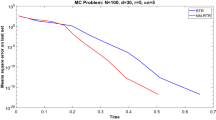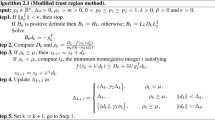Abstract
We present a trust-region method for minimizing a general differentiable function restricted to an arbitrary closed set. We prove a global convergence theorem. The trust-region method defines difficult subproblems that are solvable in some particular cases. We analyze in detail the case where the domain is a Euclidean ball. For this case we present numerical experiments where we consider different Hessian approximations.
Similar content being viewed by others
References
J.V. Burke, J.J. Moré and G. Toraldo, “Convergence properties of trust-region methods for linear and convex constraints,”Mathematical Programming 47 (1990) 305–336.
M.R. Celis, J.E. Dennis and R.A. Tapia, “A trust-region strategy for nonlinear equality constrained optimization,” in: P.T. Boggs, R. Byrd and R. Schnabel, eds.,Numerical Optimization (SIAM, Philadelphia, 1984) pp. 71–82.
A.R. Conn, N.I.M. Gould and Ph.L. Toint, “Global convergence of a class of trust-region algorithms for optimization with simple bounds,”SIAM Journal on Numerical Analysis 25 (1988) 433–460. See alsoSIAM Journal on Numerical Analysis 26 (1989) 764–767.
A.R. Conn, N.I.M. Gould and Ph.L. Toint, “Testing a class of methods for solving minimization problems with simple bounds on the variables,”Mathematics of Computation 50 (1988) 399–430.
A.R. Conn, N.I.M. Gould and Ph.L. Toint, “A comprehensive description of LANCELOT,” Hatfield Polytechnique Center, Technical Report, Hatfield (1990).
A.R. Conn, N.I.M. Gould and Ph.L. Toint, “A globally convergent augmented Lagrangean algorithm for optimization with general constraints and simple bounds,”SIAM Journal on Numerical Analysis 28 (1991) 545–572.
M. Contreras and R.A. Tapia, “Sizing the BFGS and DFP updates: a numerical study,” Technical Report 91-19, Department of Mathematical Sciences, Rice University, Houston, TX (1991).
J.H. Conway and N.J.C. Sloane,Sphere Packings, Lattices and Groups (Springer-Verlag, NY, 1988).
J.E. Dennis, J.M. Martínez, R.A. Tapia and K.A. Williamson, “An algorithm based on a convenient trustregion subproblem for nonlinear programming,” Technical Report, Department of Mathematical Sciences, Rice University, Houston, TX (1990).
J.E. Dennis and R.B. Schnabel,Numerical Methods for Unconstrained Optimization and Nonlinear Equations (Prentice-Hall, Englewood Cliffs, NJ, 1983).
R. Fletcher,Practical Methods of Optimization (John Wiley, Chichester, New York, 1987).
D.M. Gay, “Computing optimal locally constrained steps,”SIAM Journal on Scientific and Statistical Computing 2 (1981) 186–197.
P.E. Gill, W. Murray, M.A. Saunders and M.H. Wright, “Some theoretical properties of an Augmented Lagrangian merit function,” in: P.M. Pardalos, ed.,Advances in Optimization and Parallel Computing (Elsevier, Amsterdam, 1992) pp. 127–143.
M.D. Hebden, “An algorithm for minimization using exact second derivatives,” Technical Report TP515, AERE Harwell, Oxfordshire (1973).
M. Heinkenschloss, “Mesh independence for nonlinear least squares problems with norm constraints,” Technical Report 90-18, Department of Mathematical Sciences, Rice University, Houston, TX (1990).
M. Heinkenschloss, private communication (November 1990).
D.G. Luenberger,Linear and Nonlinear Programming (Addison-Wesley, Massachusetts, California, 1984).
J.M. Martínez, “Local minimizers of quadratic functions on Euclidean balls and spheres,”SIAM Journal on Optimization, 4 (1994) 159–176.
J.J. Moré, “The Levenberg—Marquardt algorithm: implementation and theory,” in: G.A. Watson, ed.,Numerical Analysis, Dundee 1977, Lecture Notes in Mathematics 630 (Springer-Verlag, Berlin, 1978) pp. 105–116.
J.J. Moré, “Recent developments in algorithms and software for trust-region methods,” in: A. Bachem, M. Grötschel and B. Korte, eds.,Mathematical Programming—The State of Art (Springer-Verlag, Bonn, 1983).
J.J. Moré, “Trust regions and projected gradients,” Technical Memorandum 107, Argonne National Laboratory, Mathematics and Computer Science Division (Argonne, Illinois, 1988).
J.J. Moré, B.S. Garbow and K.E. Hillstrom, “Testing unconstrained optimization software,”ACM Transactions on Mathematical Software 7 (1981) 17–41.
J.J. Moré and D.C. Sorensen, “Computing a trust-region step,”SIAM Journal on Scientific and Statistical Computing 4 (1983) 553–572.
S.S. Oren and D.G. Luenberger, “Self-scaling variable metric (SSVM) algorithms,”Management Science 20 (1974) 845–862.
S.S. Oren and E. Spedicato, “Optimal conditioning of self scaling variable metric algorithms,”Mathematical Programming 10 (1976) 70–90.
M.J.D. Powell and Y. Yuan, “A trust-region algorithm for equality constrained optimization,”Mathematical Programming 49 (1990) 189–211.
D.F. Shanno and K. Phua, “Matrix conditioning and nonlinear optimization,”Mathematical Programming 14 (1978) 149–160.
D.C. Sorensen, “Newton's method with a model trust-region modification,”SIAM Journal on Numerical Analysis 19 (1982) 409–426.
R.J. Stern and H. Wolkowicz, “Indefinite trust-region subproblems and nonsymmetric eigenvalue perturbations,” Technical Report SOR 93-1, Department of Civil Engineering and Operations Research, Princeton University, Princeton, NJ (1993).
A.N. Tikhonov and V.Y. Arsenin,Solutions of ill-posed problems (John Wiley, New York, Toronto, 1977).
Ph.L. Toint, “Global convergence of a class of trust-region methods for nonconvex minimization in Hilbert space,”IMA Journal on Numerical Analysis 8 (1988) 231–252.
A. Vardi, “A trust-region algorithm for equality constrained minimization: convergence properties and implementation,”SIAM Journal on Numerical Analysis 22 (1985) 575–591.
S. Vavasis, “Approximation algorithms for indefinite quadratic programming,” Technical Report 91-1228, Department of Computer Science, Cornell University, Ithaca, NY (1991).
C.R. Vogel: “A constrained least-squares regularization method for nonlinear ill-posed problems,”SIAM Journal on Control and Optimization 28 (1990) 34–49.
K.A. Williamson, “A robust trust-region algorithm for nonlinear programming,” Ph.D. Thesis, Department of Mathematical Sciences, Rice University, Houston, TX (1990).
Y. Zhang, “Computing a Celis—Dennis—Tapia trust-region step for equality constrained optimization,” Technical Report 88-16, Department of Mathematical Sciences, Rice University, Houston, TX (1988).
Author information
Authors and Affiliations
Additional information
Work partially supported by FAPESP (Grants 90-3724-6 and 91-2441-3), FINEP, CNPq and FAEP-UNICAMP.
Rights and permissions
About this article
Cite this article
Martínez, J.M., Santos, S.A. A trust-region strategy for minimization on arbitrary domains. Mathematical Programming 68, 267–301 (1995). https://doi.org/10.1007/BF01585768
Received:
Revised:
Issue Date:
DOI: https://doi.org/10.1007/BF01585768




